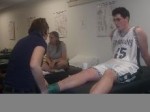Keeping the teams in action

At the end of a narrow hallway next to Glenbrook gym, athletes who walk through the door into the athletic training room are greeted by a full body skeleton hanging on a pole, its feet dangling just above the floor. Posters of muscles hang on the wall above a row of green tables with Spartans stitched into the sides. The counter opposite the mats is lined with jars full of gauze and cotton balls and a small metal container filled with sterile scissors. Behind the closed cupboards and drawers are pre-wrap, tape and other supplies to treat injured athletes.
“This will help you find out if you want to do it or not,” said senior Derek Deyong of the 800 hours each athletic training major must complete in the athletic training room before graduation — not to mention five clinical experiences with Castleton sports teams and an off campus experience as well.
“On campus you know everyone,” Deyong said, adding that working off campus with the Rutland High School football team, “it was interesting too see how to build relationships” with athletes.
Deyong said football has the most injuries, but hockey has a lot as well. Deyong, in an Easton Hockey sweatshirt, shorts, sneakers and a baseball cap, spoke of how he played Castleton hockey for three years, but took this season off to stand on the sidelines to fulfill his athletic training requirements. Deyong said he has to be “watching the injuries and not watching the game” because players often don’t tell the athletic trainer if they are injured out of fear of being benched.
Each home game has a certified athletic trainer and possibly a student trainer, but because hockey is such a contact sport, certified athletic trainer Josh Englebretson travels with the men’s hockey team to away games. Englebretson is often found in his office in the training room and interacting with students and athletes. There were a few laughs among students junior Megan Robitaille and sophomore Hilary Delp about having to cough up 25 cents to Englebretson every time they call themselves trainers instead of athletic trainers. Englebretson said it is because they are not dog trainers or circus trainers — but trainers for athletes.
“We live in here,” Robitaille said. “I guess I found my calling.”
Robitaille continued saying how she was formally a nursing major at another college then transferred to Castleton for athletic training.
“You get both perspectives,” she said about being both an athlete, playing softball for Castleton, and an athletic trainer.
She does her hours before the season starts so she does not have to worry about cramming them in during the season. Not all of the ATs are athletes and those who are can only participate in one sport a year, as a rule of the program.
There are 18 students presently in the program “with 40 freshmen interested” said certified athletic trainer Elly Ventura, who has been working at Castleton for three years, her eyes growing wider at the thought of the number. Not all will become part of the program because there is an application process with observation hours, letters of recommendation, a certain grade point average and required classes as qualifications.
“They apply spring of their freshman year, they get in fall of their sophomore year and start with the teams that semester,” Ventura said.
When asked if the program will accept all who qualify, Ventura, lying on the mat helping Robitaille study for a test the next day, pausing every few words to assist her in how to do the movements of her leg better or commenting on her doing it perfectly, said, “Most end up changing their major first. We lose a third to a half of them.”
Ventura said there isn’t a maximum number of students who can be accepted, but even after students are accepted some change their major, fall below the 2.5 required GPA or get a B- or lower in two or more of the core classes. When that happens they re-enroll in the class and try again. The student may be put on probation and once their grades are up, they can be allowed back into the program, Ventura said.
Deyong said when there are no athletes in the athletic training room, he talks with the “certifieds” discussing injuries or studies. Robitaille and sophomore Amanda Peterson do this as well, using each other to practice on because after the written test there is the lab test.
“We are given a scenario and have to solve the problem,” Robitaille said laughing and telling Peterson to cooperate while lifting her leg into a 90-degree angle then back down again.
Soon they’d switch so Peterson could practice.
Before practice, Castleton basketball team’s Zach Briggs walked in and Robitaille jumped off the table and said “Can I do it?”
With Justin Schwartz, sophomore on the Castleton ski team, in the background getting treatment for his lower back, Robitaille wrapped Briggs right ankle, which was said by many of the athletic trainers to be one of the most common injuries along with injuries wrists, knees and shoulders.





